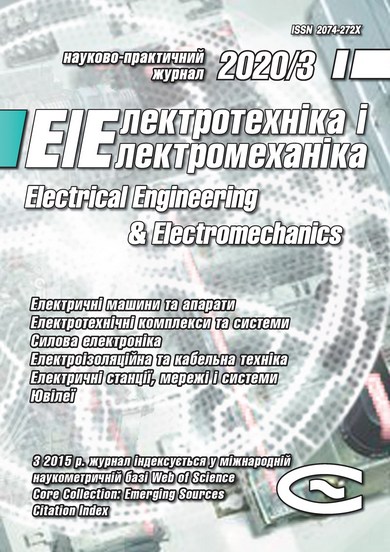PROVIDING TECHNICAL PARAMETERS OF RESISTIVE CABLES OF THE HEATING FLOOR SYSTEM WITH PRESERVATION OF THERMAL RESISTANCE OF INSULATION
DOI:
https://doi.org/10.20998/2074-272X.2020.3.07Keywords:
resistive single conductor heating cable, specific power, linear voltage, thermal stability, polyethylene thermosetting insulationAbstract
Introduction. The main purpose of resistive cables is to convert the current flowing through the cable into heat. The maximum operating temperature of the conductive core should not exceed 100 °C. Power output per cable per unit length (nominal specific electrical power per 1 m of heating cable at rated line voltage per 1m cable) is the main technical parameter of these cables. The heat released by the conductivity of the core current, taking into account the change in the resistivity of the core material from temperature, is directly proportional to the square of the linear voltage drop across the core, and inversely proportional to the linear resistance of the core. Typical heat dissipation in such cables does not exceed 10 W/m, provided the cable is placed in the air. Purpose. Determination of the specific power of the cable system when varying the thickness of the insulation and the protective polymer shell, provided the thermal stability of the insulation on the basis of thermal balance between the power released in the core and the power released into the environment from the surface of the resistive heating. Methodology. The calculation of the linear heat flux is performed in two steps: when changing the radius of insulation (thickness of insulation) and the constant thickness of the protective polymer shell; at constant thickness of insulation and change of radius of the protective polymer jacket . The highest values of linear heat flux at (70-90) W/m are achieved for the optimum design of a single-conductor resistive cable from a conductive core in the range of 0,4 mm to 1,6 mm when varying the thickness of the cross-linked polyethylene insulation and protective sheath based on polyvinyl chloride plastic. The specific power of heating resistive cables, provided the thermal stability of the crosslinked polyethylene insulation is determined based on the thermal balance between the power generated in the core and the power dissipated from the surface of the cable into the air. Practical value. The thickness of the insulation and the linear voltage of the heating resistive cable, depending on the material of the core, providing thermal stability of the insulation are substantiated. The methodology of substantiation of specific power, which corresponds to thermal stability of heating resistive cables on the basis of thermal balance, can be applied to both the floor heating system and other areas of application of heating cables.References
DNAOP 0.00-1.32-01. Pravyla ulashtuvannia elektroustanovok. Elektroobladnannia spetsialnykh ustanovok [DNAOP 0.00-1.32-01. Rules of arrangement of electrical installations. Electrical equipment of special installations]. Kyiv, 2001. (Ukr).
DBN V.2.5-24-2012 Elektrychna kabelna systema opalennia [DBN B.2.5-24-2012. Electric cable heating system]. Kyiv, Minregion ofUkraine Publ., 2012. 83 p. (Ukr).
Mikhailin Yu.A. Teplo-, termo- i ognestoikost' polimernykh materialov [Heat, thermal and fire resistance of polymeric materials].St. Petersburg, Scientific Foundations and Technologies Publ., 2011. 416 p. (Rus).
DEVI Cable Systems. Manual. Kyiv, 2018. 52 p. Available at: https://devi.rv.ua/data/pages/img/63/DEVI_posibnyk_2018.pdf (accessed 20 June 2018). (Ukr).
Strupinskii M.L., Khrenkov N.N., Kuvaldin A.B. Proektirovanie i ekspluatatsiia sistem elektricheskogo obogreva v neftegazovoi otrasli [Design and operation of electric heating systems in the oil and gas industry].Moscow, Infra-Inzheneriia Publ., 2015. 272 p. (Rus).
Bezprozvannych G.V., Mirchuk I.A. Optimization of design of power ship cables under conditions of cooling in operation. Bulletin of NTU «KhPI», 2019, no. 42 (948), pp. 65-68. (Rus).
Bezprozvannych G.V., Naboka B.G. Matematicheskie modeli i metody rascheta elektroizoliatsionnykh konstruktsii [Mathematical models and methods of calculation of electrical designs]. Kharkiv, NTU «KhPI» Publ., 2012. 108 p. (Rus).
IEC 60287-2-1: 2001. Electric cables. Calculation of the current rating. Part 2-1: Thermal resistance – Calculation of thermal resistance. – 84 p.
Bezprozvannych G.V., Zolotaryov V.M., Antonets Yu.A. Effect of the thickness of insulation of protected wires of high-voltage overhead transmission lines to their current carrying capacity. Electrical engineering & electromechanics, 2018, no. 2, pp. 41-46. doi: 10.20998/2074-272X.2018.2.07.
Carslaw H.S., Jaeger J.C. Conduction of heat in solids. Second Ed. Clarendon Press, London, 2003. 510 p.
Downloads
Published
How to Cite
Issue
Section
License
Copyright (c) 2020 G. V. Bezprozvannych, M. V. Grynyshyna, A. G. Kyessayev, O. M. Grechko

This work is licensed under a Creative Commons Attribution-NonCommercial 4.0 International License.
Authors who publish with this journal agree to the following terms:
1. Authors retain copyright and grant the journal right of first publication with the work simultaneously licensed under a Creative Commons Attribution License that allows others to share the work with an acknowledgement of the work's authorship and initial publication in this journal.
2. Authors are able to enter into separate, additional contractual arrangements for the non-exclusive distribution of the journal's published version of the work (e.g., post it to an institutional repository or publish it in a book), with an acknowledgement of its initial publication in this journal.
3. Authors are permitted and encouraged to post their work online (e.g., in institutional repositories or on their website) prior to and during the submission process, as it can lead to productive exchanges, as well as earlier and greater citation of published work.





